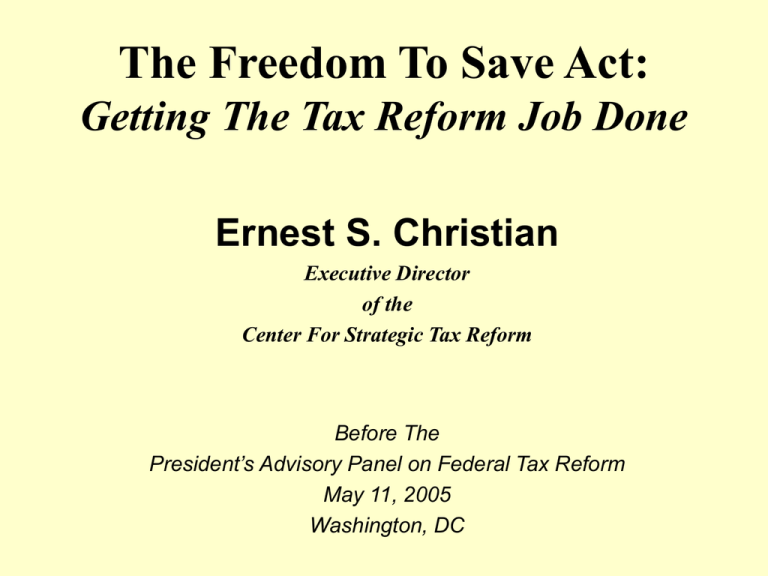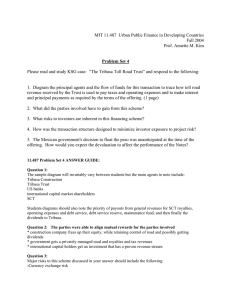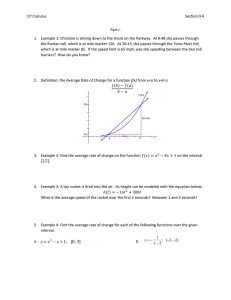The Freedom To Save Act: Getting The Tax Reform Job Done
advertisement

The Freedom To Save Act: Getting The Tax Reform Job Done Ernest S. Christian Executive Director of the Center For Strategic Tax Reform Before The President’s Advisory Panel on Federal Tax Reform May 11, 2005 Washington, DC Relief From Double Taxation I urge first-year expensing for businesses and Universal Savings and Investment Accounts (USIA) for individuals This relief from double taxation --Achieves 80 to 90 percent of the economic goals of “Big Bang” tax reform -Forever changes the tax code’s anti-capital character -Can readily be made revenue neutral -Stands an excellent chance of being enacted Step Two is to enact the Simplified USA Tax (SUSAT) -Historic simplification of the tax code (as per H.R. 269 in the 108th Congress) -Non-radical international tax reform that allows Americans to compete and win in global markets The Core Component of Tax Reform Elimination of double taxes on savings and investments is the core economic component of all tax reform proposals -Some proposals do it in unfamiliar ways -Others are experimental -- and have uncertain side effects The tried and true way is to stay within the familiar framework of the current code -First-year expensing has predictable results based on experience - USIAs are patterned after the familiar Roth IRA Keeping Our Eye On The Ball Why go searching for some new magic elixir that may have unknown results? -With expensing and USIAs, there is only an upside and we know what it is Every tax reformer’s inclination is to propose something dramatic -- something that will capture the public’s imagination But real tax reform is not about dramatic “proposals,” it is about dramatic “accomplishments” The combination of first-year expensing and USIAs gets the job done Expensing Versus Depreciation -- A Timing Issue Because depreciation postpones deductions, it requires businesses to prepay tax -Thus, government tax receipts are increased up front but are lesser by the same amount in the future -Prepaying tax increases the cost of capital equipment for a business First-year expensing is the opposite: It allows the deductions to be taken now instead of later -With expensing, government tax receipts are reduced up front but are greater by the same amount in the future compared to depreciation -Expensing reduces the cost of capital equipment compared to depreciation The revenue cost of switching to expensing starts out large, as continuing depreciation deductions on pre-effective-date assets stack up on top of expensing deductions for new assets -But, after three years, the impact of the carryover depreciation deductions starts to diminish, and the revenue cost quickly declines Switching to Expensing: Example of Revenue Cost Pattern* -In this example, the cumulative revenue cost over ten years is $752 billion -But the PV (in Year 1) of that 10-year cost is $603 billion $140 Year Cost PV of Cost 1 $23 $23 2 $114 $108 3 $123 $109 4 $112 $94 5 $102 $81 6 $75 $56 7 $60 $42 8 $51 $34 9 $47 $29 10 $45 $27 TOTAL $752 $603 $120 $100 $Billions $80 $60 $40 $20 $0 1 2 3 4 5 6 7 8 9 10 Year *Equipment Expensing in $Billions, Part-Year Convention Source: Fiscal Associates Universal Savings and Investment Accounts A USIA account is like a Roth IRA -- except that it is unlimited and not restricted to retirement savings -Deposits in USIAs are made out of current-year earnings -Americans can save in a USIA for whatever purpose they want -They can withdraw their money whenever they wish USIAs will function much like a combination brokerage and checking account -Because USIAs are funded with after-tax savings, withdrawals are not taxed -- and interest, dividends and capital gains on investments inside the account are taxed at a zero rate The pattern of revenue losses from USIAs is just the opposite from that of first-year expensing -Because USIAs allow no up-front deduction, the revenue loss is small in the beginning and builds up over time as greater amounts of dividends, interest and gains are received in those accounts without further taxation Paying for the Revenue Cost with a Voluntary Toll Charge The revenue cost of first-year expensing and USIAs can be paid for --Step One: Expand USIA accounts to apply to existing savings as well as to new savings out of current earnings -Step Two: Charge the owners of existing portfolios who want to put their savings in a USIA account a toll charge for the privilege of doing so Many tax reform proposals automatically exclude from additional tax all future interest, dividends and gains on existing portfolios -And tend to pay for the revenue cost with radical changes elsewhere in the tax code The future yields on all after-tax savings (old and new) should be free of additional tax -- but the “transition” should be paid for in a traditional way by those who most directly benefit Everyone who has retirement savings in §401(k) or other tax-deferred accounts should be given the option of paying a realistic toll charge for converting those accounts to Roth IRAs B.100.e Balance Sheet Data From Federal Reserve Billions of dollars; amounts outstanding end of period, not seasonally adjusted Original Line No. 3 Description Financial assets 2001 2002 2003 2004 32,210.7 29,866.6 34,092.1 36,758.5 4 Deposits 4,800.7 5,071.8 5,251.8 5,693.8 5 Credit market instruments 2,176.4 2,074.8 2,242.1 2,265.0 6 Equity shares at market value 13,106.9 10,051.2 13,051.1 14,278.0 7 Directly held 6,604.2 5,047.8 6,375.8 6,521.6 8 Indirectly held 6,502.8 5,003.5 6,675.2 7,756.5 9 Bank personal trusts and estates 527.0 385.0 469.7 504.5 10 Life insurance companies 806.5 692.5 887.3 1,056.2 11 Private pension funds 2,208.1 1,611.3 2,180.7 2,463.1 12 Defined benefit plans 825.7 535.3 764.3 860.0 13 Defined contribution plans 1,382.4 1,076.0 1,416.4 1,603.1 14 State and local govt. retirement funds 1,084.0 869.8 1,084.4 1,204.7 15 Federal government retirement funds 49.1 45.9 79.9 99.3 16 Mutual funds 1,828.1 1,399.0 1,973.2 2,428.7 12,126.7 12,668.7 13,547.1 14,521.7 17 Other Potential Approximate Amount Transferable to USIA (or Roth IRA) Liquid assets (4+5+7+13+16) 18,512.2 20% of less liquid assets (17) 2,904.3 TOTAL APPROXIMATE AMOUNT 21,416.5 Source: Flow of Funds Accounts for the United States, March 2005, Board of Governors of the Federal Reserve System, Washington D.C. 20551. Theory and Amount of Toll Charge Economists tell us that a share of stock is worth the discounted present value of the future stream of dividends and gains that the market predicts it will produce -Thus, the capital invested in the stock and the future stream are two versions of the same thing and both should not be taxed Under current law, the owner of the stock is required to pay a 15 percent tax on those future dividends and gains -- and because the value of the stock is equal to the present value of the future stream, current law in effect imposes a 15 percent tax on the value of stock -If, however, the share of stock is in a USIA, the owner will not pay tax on the stream of dividends and gains in the future -- and, therefore, the 15 percent tax on the value of the stock is removed In exchange for removing that 15 percent tax on the value of the stock, a onetime, voluntary toll charge of 10 percent of the value of the stock is suggested A Simplified Example of the Toll Charge Present Law: Jones owns a stock that will produce a pre-tax stream of dividends and gains that has a present value of $117.65 -However, because dividends and gains are taxed at 15 percent, the present value of the after-tax stream is only $100 and the stock is worth only $100 USIA Format: Jones paid $100 for the stock. Now, he pays a 10 percent ($10) toll charge for a total of $110. The present value of the future stream of dividends and gains is $117.65 -- and because the tax rate is zero, Jones gets to keep the entire amount. Having paid $110 (including the toll charge) for a stream of dividends and gains worth $117.65, Jones is $7.65 better off As a result, Jones would be strongly motivated to put the stock in a USIA account and pay the toll charge Reasonably Predictable Results Experience with Other Toll Charges -Indications are that the repatriation rate of accumulated foreignsource income subject to a 5.2 percent toll charge pursuant to American Jobs Creation Act (AJCA) of 2004 is going to be about 50 percent of the amount eligible and perhaps closer to 100 percent of liquid assets where the repatriation is beneficial to the taxpayer -Conversions of regular IRAs to Roth IRAs have been going on since 1997 even though the option is severely restricted and the toll charge is very high -With a 10 percent toll charge, it is likely that the transfer rate into USIAs (and conversions to Roth IRAs) would be at least 50 percent -and the transfer rate could be higher Revenue Results of 10 Percent Toll Charge With Two Assumed Transfer and Conversion Rates 50 Percent . . . . . . . . . . . . . + $ 1.07 Trillion 75 Percent . . . . . . . . . . . . . + $ 1.61 Trillion Approximate Net Present Value Budget Impact of Proposals ($ Billions) 10% Toll Charge 12% Toll Charge Transfer Rate Expensing Cost Lost Dividend & Capital Gains Taxes 50% ($603) ($328) + $1,071 + $140 75% ($603) ($492) + $1,606 + $511 50% ($603) ($328) + $1,285 + $354 75% ($603) ($492) + $1,927 + $833 Toll Charge Net Budget Effect Assumes 6% federal government borrowing and discount rate Source: Fiscal Associates Conclusion: Simple and Effective Tax Reform I am not undertaking to give precise revenue estimates -- nor do I say that my way of calculating the toll charge is the only way Rather, I am suggesting a basic analysis from which I believe that certain important conclusions flow -The use of a toll charge is a workable idea with which we have experience -An official revenue estimate can be made drawing upon the expertise of the Treasury Department and the financial community -The toll charge could pay for part, all or more than the revenue cost of first-year expensing and USIAs Therefore, I conclude that this simple and effective approach to tax reform should be included in this Panel’s recommendations Appendix Explanation of Table Entitled “Approximate Net Present Value Budget Impact of Proposals” On the line showing the result of a 10-percent toll charge applied on the assumption of a 50-percent transfer rate -$603 billion is the present value of the nominal $752 billion 10-year revenue cost of expensing -$328 billion is 50 percent of the present value ($655 billion) of the $840 billion nominal 10-year revenue cost of excluding all dividends and capital gains from tax under present law -$1,070 billion is both the nominal and present value of one-half of a 10-percent toll charge applied to a base of $21,416 billion The Table is intended to encapsulate the way that the combination of expensing, USIAs and the toll charge would typically be presented in the budget documents which take into account (as they must) both interest costs and interest savings -For example, in the budget presentation, the cost of expensing plus the interest cost to the government on that lost revenue would be presented in annual increments over the budget period -Similarly, as an offset thereof, the upfront revenue gain from the toll charge plus the annual interest cost savings to the government would be presented over that same budget period -The net present value presentation in the Table collapses these costs and savings over a number of years to an equivalent current valuation using an interest rate equal to the government borrowing rate


